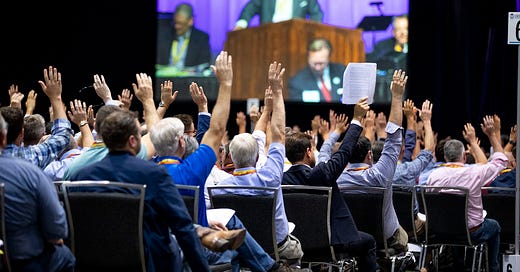Assembly Demographics Matter in the PCA
The RE/TE balance is improving...or returning to "normal." - by Brad Isbell
The Presbyterian Church in America—if judged by General Assembly actions in the last 15 years—is changing,1 and so is the proportion of ruling elders to teaching elders who attend those assemblies. I first wrote of RE/TE percentages in 2018, the nadir of RE attendance. From 2014-2018 ruling elders made up less than 22% of GA commissioners. Then something (or a few things) happened.
What happened? The Revoice controversy played an obvious part in motivating lay elders to attend. So did efforts to raise awareness, encourage RE attendance, and assist REs with GA attendance expenses. Since 2019 unofficial events have been held at the assemblies to encourage REs and give them something to do while their pastors schmooze and catch up with old acquaintances. The increase in RE attendance is not radical—it simply represents a return to levels of previous decades:
1973-1979 - 44% (!)2
1980-1989 - 32% (the largest downward change—RPCES effect?)
1990-1999 - 32%
2000- 2009 - 29%
2010-2019 - 23%
2021-2024 - 30%3 (these years have also seen the PCA’s largest assemblies)4
Ironically, the decline in ruling elder attendance might have resulted from denominational growth. 1982’s receiving of the RPCES, far-flung expansion (like Canada and the West Coast), and growing numbers of Korean churches (who send very few ruling elders) may have played a part. The recent upsurge in ruling elder attendance merely represents a return to the levels of 1980-2009.
Time will tell whether something around 30% is the “new normal” (as it was for 30 years the old normal) or if the numbers of REs will continue to rise.
In 2018 I wrote:
The lack of parity may seem like a minor issue to some. Some may think that ministers know best and ought to dominate the church courts. Others point to the benefits that the diversity of life experience and real-world perspective that ruling elders bring to the church courts. They also point out that it would be a shame to see a “grassroots” Presbyterian body devolve into a de facto form of episcopacy, run almost exclusively by clergy.5
The principles and provisions that afford equal access of both classes of elders to church court participation are not accidental—they are built into the system for good reason:
The reason for this parity of elders principle is obvious—the founders of the PCA viewed ruling elders as a reliable, commonsense bulwark against doctrinal and denominational decline. The founders were not insensible to the fact that teaching elder professors and influential large-church pastors had presided over the liberalization of the old Southern mainline church from whence the PCA came. The late increase in ruling elder participation is a fitting tribute to the founders of the PCA, many of whom were ruling elders.6
Stated Clerk Emeritus Roy Taylor wrote many years ago that “The PCA was started primarily through the efforts of Ruling Elders.” If the PCA remains faithful in the 21st century—despite cultural headwinds and decline—it may also be because of the efforts and participation of ruling elders.
This interesting piece speaks of some of the “changing.” https://heidelblog.net/2024/06/a-new-decade-irony-continues-at-ga-51-part-2/
Over half the commissioners at the first GA in 1973 (53.7%) were REs.
All figures taken from the PCA Historical Center.
The unofficial attendance figures for 2024: 651 REs and 1463 TEs for a total of 2114.




The EPC polity calls for 2 REs for every TE serving as a pastor or associate pastor in every congregation. This increases GA and Presbytery involvement by REs, and was salutary in my experience in that denomination (2001-2010) as a TE. I don't know how it's gone since then. But in my EP years it always allowed for a much closer parity in the courts of the Church.